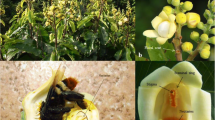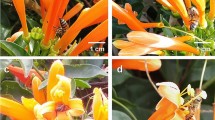Abstract
Carpenter bees (Xylocopa spp.) act as primary nectar thieves in rabbiteye blueberry (Vaccinium ashei Reade), piercing corollas laterally to imbibe nectar at basal nectaries. Honey bees (Apis mellifera L) learn to visit these perforations and thus become secondary nectar thieves. We tested the hypothesis that honey bees make this behavioral switch in response to an energetic advantage realized by nectar-robbing flower visits. Nectar volume and sugar quantity were higher in intact than perforated flowers, but bees (robbers) visiting perforated flowers were able to extract a higher percentage of available nectar and sugar so that absolute amount of sugar (mg) removed by one bee visit is the same for each flower type. However, because perforated flowers facilitate higher rates of bee flower visitation and the same or higher rates of nectar ingestion, they are rendered more profitable than intact flowers in temporal terms. Accordingly, net energy (J) gain per second flower handling time was higher for robbers on most days sampled. We conclude that the majority evidence indicates an energetic advantage for honey bees that engage in secondary nectar thievery in V. ashei.
Similar content being viewed by others
References
Corbet SA (2003) Nectar sugar content: estimating standing crop and secretion rate in the field. Apidologie 34:1–10
Corbet SA, Saville NM, Fussell M, Prys-Jones OE, Unwin DM (1995) The competition box: a graphical aid to forecasting pollinator performance. J Appl Ecol 32:707–719
Dafni A (1992) Pollination ecology: a practical approach. Oxford University Press, New York
Dedej S (2004) Bee foraging behavior and pollinating activity on rabbiteye blueberry Vaccinium ashei Reade. PhD Thesis, University of Georgia, Athens
Dedej S, Delaplane KS (2004) Nectar-robbing carpenter bees reduce seed-setting capability of honey bees (Hymenoptera: Apidae) in rabbiteye blueberry Vaccinium ashei Reade ‘Climax’. Environ Entomol 33:100–106
Delaplane KS, Mayer DF (2000) Crop pollination by bees. CABI, Oxon
Faegri K, Van der Pijl LW (1979) The principles of pollination ecology (3rd edn). Pergamon, Oxford
Farina WM, Wainselboim AJ (2001) Changes in thoracic temperature of honey bees while receiving nectar from foragers collecting at different reward rates. J Exp Biol 204:1653–1658
Free JB (1993) Insect pollination of crops. Academic, London
Gilbert FS, Haines N, Dickson K (1991) Empty flowers. Funct Ecol 5:29–39
Harder LD, Cruzan MB (1990) An evaluation of the physiological and evolutionary influences of inflorescence size and flower depth on nectar production. Funct Ecol 4: 559–572
Harder LD, Real RA (1987) Why are bumblebees risk-averse? Ecology 68:1104–1108
Harrison JF, Camazine S, Marden JH, Kirkton SD, Rozo A, Yang X (2001) Mite not make it home: tracheal mites reduce the safety margin for oxygen delivery of flying honeybees. J Exp Biol 204:805–814
Heinrich B (1993) The hot-blooded insects: strategies and mechanisms of thermoregulation. Harvard University Press, Cambridge, Mass
Hodges CM, Wolf LL (1981) Optimal foraging in bumblebees—why is nectar left behind in flowers? Behav Ecol Sociobiol 9:41–44
Inouye DW (1983) The ecology of nectar robbing. In: Bentley B, Elias T (eds) The biology of nectaries. Columbia University Press, New York
Irwin RE, Brody AK, Waser NM (2001) The impact of floral larceny on individuals, populations, and communities. Oecologia 129 (2):161–168
Kearns CA, Inouye DW (1993) Techniques for the pollination biologist. University Press of Colorado, Boulder
Lyrene PM (1994) Variation within and among blueberry taxa in flower size and shape. J Am Soc Hortic Sci 119:1039–1042
Maloof JE (2001) The effect of bumble bee nectar robbery on plant reproductive success and pollinator behavior. Am J Bot 88:1960–1965
Maloof JE, Inouye DW (2000) Are nectar robbers cheaters or mutualists? Ecology 81:2651–2661
Navarro L (2001) Reproductive biology and effect of nectar robbing on fruit production in Macleania bullata (Ericaceae). Plant Ecol 152:59–65
Núñez JA, Giurfa M (1996) Motivation and regulation of honey bee foraging. Bee World 77:182–196
Pleasants JM (1983) Nectar production in Ipomopsis aggregata (Polemoniaceae). Am J Bot 70:1468–1475
SAS Institute (1992) SAS/STAT user’s guide, version 6, 4th edn. SAS Institute, Cary
Schmidt-Nielsen K (1997) Energy metabolism. In: Schmidt-Nielsen K (ed) Animal physiology, adaptation and environment, 5th edn. Cambridge University Press, Cambridge, pp 169–214
Seeley TD (1985) Honeybee ecology: a study of adaptation in social life. Princeton University Press, Princeton
Stabentheiner A, Vollmann J, Kovac H, Crailsheim K (2003) Oxygen consumption and body temperature of active and resting honeybees. J Insect Physiol 49:881–889
Stout JC, Allen JA, Goulson D (2000) Nectar robbing, forager efficiency and seed set: bumblebees foraging on the self-incompatible plant Linaria vulgaris (Scrophulariaceae). Acta Oecol 21:277–283
Suarez RK, Lighton JRB, Joos B, Roberts SP, Harrison JF (1996) Energy metabolism, enzymatic flux capacities, and metabolic flux rates in flying honeybees. Proc Natl Acad Sci USA 93:12616–12620
Winston ML (1987) The biology of the honey bee. Harvard University Press, Cambridge
Wolf THJ, Schmid-Hempel P, Ellington CP, Stevenson RD (1989) Physiological correlates of foraging efforts in honey-bees: oxygen consumption and nectar load. Funct Ecol 3:417–424
Acknowledgements
We thank John Ruberson for supplying cages, Glenn O. Ware for assistance in experimental design and analysis, and Jennifer Berry for help in the field. The research described herein was conducted in compliance with all applicable laws of the United States of America and State of Georgia.
Author information
Authors and Affiliations
Corresponding author
Additional information
Communicated by R. Page
Rights and permissions
About this article
Cite this article
Dedej, S., Delaplane, K.S. Net energetic advantage drives honey bees (Apis mellifera L) to nectar larceny in Vaccinium ashei Reade. Behav Ecol Sociobiol 57, 398–403 (2005). https://doi.org/10.1007/s00265-004-0852-z
Received:
Revised:
Accepted:
Published:
Issue Date:
DOI: https://doi.org/10.1007/s00265-004-0852-z




